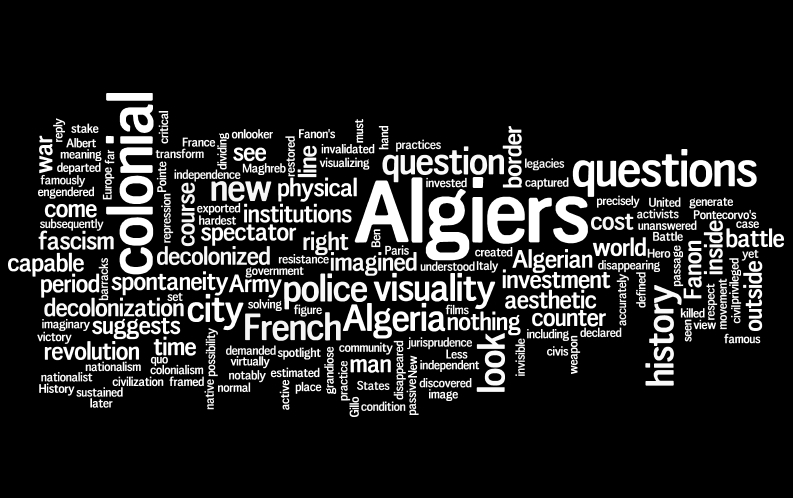Enter
"A new international is being sought through these crises"
Jacques Derrida
 This project uses the metaphor of a demonstration to stage its narrative of visuality, revolution and decolonization in Algeria (1954-2011). It follows Jacques Rancière in seeing such events as the moment where it is possible to stage the people (abstract). It is in or in support of "Algeria," whether as a formerly colonized nation seeking independence or as a metonym for those processes. The project explores the visualization of decolonization and revolution in Algeria and North Africa from the point of view of the child, meaning both children as such, and the colonized "child" of the parent nation.
This project uses the metaphor of a demonstration to stage its narrative of visuality, revolution and decolonization in Algeria (1954-2011). It follows Jacques Rancière in seeing such events as the moment where it is possible to stage the people (abstract). It is in or in support of "Algeria," whether as a formerly colonized nation seeking independence or as a metonym for those processes. The project explores the visualization of decolonization and revolution in Algeria and North Africa from the point of view of the child, meaning both children as such, and the colonized "child" of the parent nation.Algeria
is a metonym for the interface of decolonization and
globalization
Whether or not you work "on" Algeria,
there is an "Algeria" in your work,
meaning that there is a place where the incomplete or failed processes of decolonization
and the formation of independent developing-world nations
intersects
with the homogenizing tendencies of globalization.
These
interfaces
are places of conflict and revolution
In the aftermath of the light of the 2011 revolutionary movement that has swept across the region and indeed the world, this is a project about possible futures as well as recoverable pasts.
there is an "Algeria" in your work,
meaning that there is a place where the incomplete or failed processes of decolonization
and the formation of independent developing-world nations
intersects
with the homogenizing tendencies of globalization.
These
interfaces
are places of conflict and revolution
In the aftermath of the light of the 2011 revolutionary movement that has swept across the region and indeed the world, this is a project about possible futures as well as recoverable pasts.
These pasts and futures are the product of long and entangled interfaces that we are going to walk through, remember, reanimate and (re)claim. This argument is made in the text and the to-camera videos in a broadly conventional way. There is a parallel case being made that the digital format, allowing as it does for a set of intersecting and interfacing threads to compose the whole, is in fact better suited to reclaiming and exploring these histories. To anticipate the project, that should not surprise us, given the extent to which "History" was formed as a technology of empire. While there is no innocence attached to computing or authoring softwares, there is at least a certain open space which, for the present, we can explore.
The Way Ahead
| Previous page on path | Main Route, page 1 of 13 | Next page on path |
Discussion of "Enter"
Add your voice to this discussion.
Checking your signed in status ...